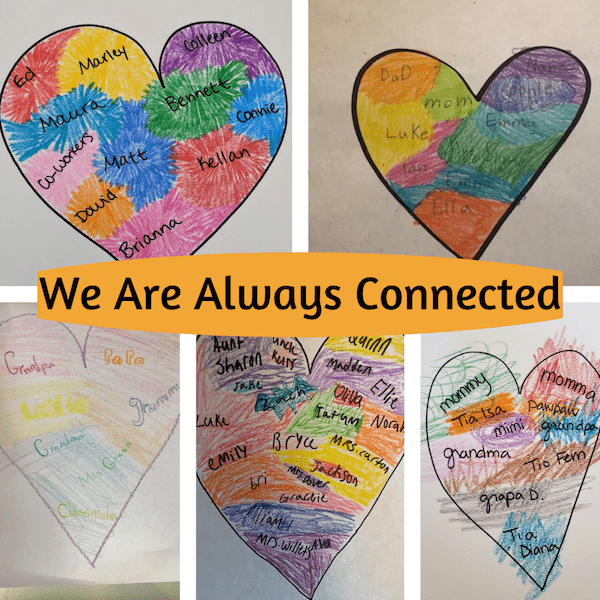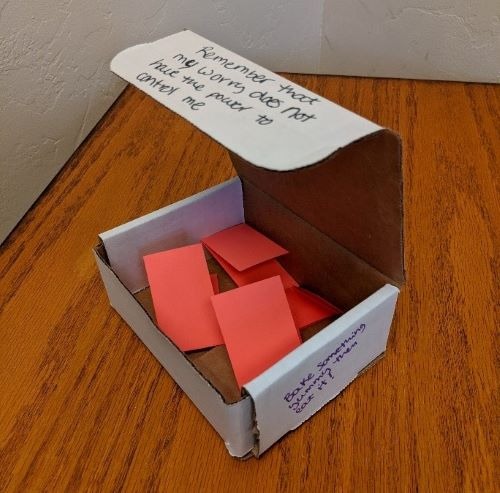We Are Always Connected
Online curriculum for children and families impacted by grief
If you have questions or would like guidance around this curriculum, contact us! We are still available by phone and email. Leave us a message and we will get back to you promptly.
(520) 322-9155 | [email protected]
Topic: We Are Always Connected
It feels really hard to not be with the people we care about right now. We can’t go to school and see our friends and classmates. If we go outside to play, we can’t play with other kids. Some of us can’t even see our own family members. When someone special has a serious medical condition, or after someone special has died, being able to be with the people we care about helps us feel better. The Invisible String helps remind us that even when we can’t be with the people we love and care about, we are always connected to them.
Start by following along with Kristin as she reads The Invisible String by Patrice Karst, Illustrated by Geoff Stevenson. Thank you to the Publishers of this book, DeVross & Company and Little, Brown & Company: Books for Young Readers!
Littles and Middles (age 3 ½ – 12):
Activity: Heart of Connections
Supplies Needed:
- Blank piece of paper
- Markers
- Crayons or colored pencils
Steps:
- Start by getting a blank piece of paper and draw a big heart on it. Think of everyone you would like to be with, but can’t: your special person, friends, family members, teachers, classmates, neighbors. . . anyone!
- Draw a picture of each of these people or write their names inside of the heart.
- Then, color each person using their favorite color or a color you think they would love. Watch as all of the colors connect!
- When you are feeling sad and missing these people, look at your heart and remember that even though you can’t be with them, you are always connected to them and they are always connected to you.
Teens (ages 13-18):
When you think of the people in your life who you care about like your special person, friends, and family, your first thoughts might be about how wonderful, dependable, and loving they are. When you think of a spider web your first thoughts might be how creepy or gross it is. If thoughts of people you care about and spider webs seem so different, why would we ever compare them? Surprisingly, they have some similarities.
- Spider webs are incredibly strong. When we are separated from people we care about, we can find comfort in the strong bonds we have with them.
- Spider webs are surprisingly beautiful. The relationships you have with those in your life who you love are beautiful too.
- Spider webs are unique. The connections you have with caring, loving people are one of a kind and incredibly special.
During this time when we are all social distancing, we might be worried about losing connections with important people in our lives. If we think of how our connections to these people are strong, beautiful, and unique we can remind ourselves that they will last. If you feel inspired to create a visual reminder of this, try the following activity!
Activity: Spider Web Connections


Supplies Needed:
- Printed Spider Web Image
- Something to write with
Steps:
- Print our spider web image (or draw your own!)
- Write the names of your special person, friends, family members, classmates, etc. throughout the web (example above).
- Place your web somewhere that you will always see it. Glance at it when you are missing these people to remind yourself that your connections will last because they are strong, beautiful and unique.
Adults and Caregivers:
A diagnosis of a serious medical condition or a loved one’s death greatly impacts relationships. Some connections may become stronger while others slowly fade away or abruptly come to an end. During this time when we are all social distancing, we might be worried about losing connections with additional people in our lives. This is a natural concern that many people are experiencing. This article from our friends at What’s Your Grief? normalizes this concern from the lens of a griever, while encouraging acts that may lead to reconnection with people who we miss and need. While this article was written in November 2017, well before the pandemic, we hope you still find it comforting and validating.
We’d love to see your artwork!
Share your creation with us by sending a picture of your artwork to [email protected] or posting it with the hashtag #TuNiditoArt. And remember, we are available for support at (520) 322-9155.
Si tiene preguntas o necesita guía o apoyo, nos puede contactar a Tu Nidito al 520-322-9155 | [email protected].
Tema: Siempre Estamos Conectados
Es realmente duro no estar con la gente que queremos en estos momentos. No podemos ir a la escuela y ver a nuestros amigos y compañeros de escuela. Si salimos a jugar, no podemos jugar con otros niños. Algunos de nosotros no podemos ni siquiera ver a nuestros seres queridos. Cuando alguien especial tiene una enfermedad seria o después de que alguien especial a muerto, tener la oportunidad de estar con la gente que queremos nos ayuda a sentirnos mejor. El hilo invisible nos ayuda a recordar que incluso cuando no podemos estar con la gente que queremos, siempre estaremos conectados a ellos.
Empieza esta actividad siguiendo a Kristin mientras lee “El hilo invisible” por Patrice Karst, Ilustrado por Geoff Stevenson. Gracias a los editores de este libro DeVross & Company and Little, Brown & Company: Books for Young Readers!
Pequeños y medianos (edades 3 ½ – 12):
Actividad: Corazón de conexiones
Materiales necesarios:
- Hoja de papel en blanco
- Marcadoeres
- Crayolas o colores
Pasos:
- Empiecen por tomar una hoja en blanco y dibujen un gran corazón.
- Piensa en todas esas personas con las que te gustaría estar, pero no puedes: Tu persona especial, amigos, familia, maestros, compañeros de clase, vecinos… cualquier persona!
- Dibuja a cada una de esas personas o escribe su nombre adentro del corazón.
- Después, colorea a cada una de las personas con su color favorito o con el color que tu piensas es su favorito.
- Observa como todos los colores se conectan! Cuando te sientas solo y que extrañas a estas personas, ve a tu corazón y recuerda que, aunque no puedes estar con ellos, ellos estarán siempre conectados contigo.
Adolescentes (edades 13-18):
Cuando piensas en aquellas personas a las que quieres, como tu persona especial, amigos, familia, tal vez lo primero que se te viene a la mente es lo maravillos, confiables y amorosos que son. Cuando piensas en una telaraña, tal vez lo primero que se te viene a la mente es lo espeluznante y asquerosas que son. Si pensar en la gente que quieres y telarañas son tan diferentes, porque deberíamos de compararlos? Sorprendentemente, tienen varias similitudes.
- Las telarañas son increíblemente fuertes. Cuando somos separados de la gente que queremos, podemos encontrar confort en los lazos fuertes que tenemos con ellos.
- Las telarañas son sorprendentemente bonitas. Las relaciones que tienes con las personas que quieres, también son bonitas.
- Las telarañas son únicas. Las conexiones que tienes con gente que es amable, amorosa, cuidadosos son increíblemente especiales.
Durante este tiempo que estamos practicando distanciamiento social, podemos estar preocupados acerca de perder conexiones con gente importante en nuestras vidas. Si nos ponemos a pensar en como nuestras conexiones con esa gente son fuertes, hermosas y únicas, podemos recordar que van a durar. Si te sientes inspirado a crear una imagen acerca de esto, haz la actividad:
Actividad: Telarañas de conexiones


Materiales necesarios:
- Imagen de la telaraña
- Algo para escribir en la imagen
Pasos:
- Imprime nuestra telaraña, o crea tu propia imagen.
- Escribe los nombres de tu persona especial, amigos, familia, compañeros de clase, etc. por toda la telaraña.
- Ve esa imagen cuando extrañes a esa gente para que recuerdes que las conexiones van a durar porque son fuertes, hermosas y únicas.
Adultos y Cuidadores:
El diagnostico de una enfermedad seria o la muerte de una persona especial impacta nuestras relaciones. Algunas conexiones se pueden volver mas fuertes mientras que otras, desaparecen lentamente o terminan repentinamente. Durante este tiempo que estamos practicando distanciamiento social, tal vez nos preocupe perder conexiones con personas en nuestras vidas. Este es una preocupación normal que mucha gente esta experimentando. Este articulo de nuestros amigos de What’s Your Grief? Normalizan esta preocupación desde el lente del afligido, mientras que alientan actos que pueden ayudar a reconectar con gente que extrañamos y necesitamos. Mientras que este articulo fue escrito antes de la pandemia, en Noviembre del 2017, esperamos que encuentre el articulo reconfortante y valioso.
¡Nos encantaría ver que es lo que estas dibujando!
Comparte con nosotros mandando una fotografía de tu arte a [email protected] o usa el hashtag #TuNiditoArt. Y recuerda, estamos disponibles para apoyarte al (520) 322-9155



































